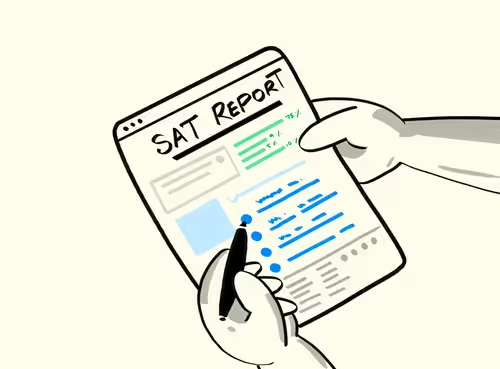


Key Takeaways
- Increased SAT Participation: SAT participation rose significantly in 2023, with 1.9 million students taking the test compared to 1.7 million in 2022, driven largely by the SAT School Day program.
- Popularity of SAT School Day: The SAT School Day program accounted for 67% of all SAT test-takers, offering convenience, accessibility, and inclusivity, particularly benefiting underrepresented students.
- Mean SAT Scores Analysis: The average SAT score for the class of 2023 declined to 1028 from 1050 in 2022, but 40% of students met benchmarks for college readiness in both ERW and Math.
Introduction
The recently released 2023 SAT Suite of Assessments Annual Report brings encouraging news about the continued growth in SAT participation, especially through the SAT School Day program. In this detailed blog, we'll delve into the key findings, shedding light on the evolving landscape of standardized testing in the wake of test-optional admissions policies.
Rising Participation Rates
In a notable shift, the 2023 SAT Suite of Assessments Annual Report shines a spotlight on a substantial increase in SAT participation among high school students. The data reveals a noteworthy surge from the previous year, with 1.9 million students from the class of 2023 engaging with the SAT at least once. This represents a significant uptick from the 1.7 million participants in the class of 2022, underscoring a growing interest in standardized testing.
Exploring the Dynamics of SAT School Day
One particularly intriguing trend that emerges from the report is the pronounced preference for SAT School Day among test-takers. A remarkable 67% of students opted for the convenience and accessibility offered by in-school testing. SAT School Day, designed to facilitate testing during regular school hours, has clearly gained traction, revealing its popularity as the chosen mode for a substantial majority of participants.
This shift towards in-school testing suggests a myriad of potential factors driving this choice. The convenience of taking the SAT within the familiar environment of their educational institution, coupled with the possible elimination of logistical barriers, may contribute to the rising appeal of SAT School Day. The 67% adoption rate indicates a widespread recognition of the benefits associated with in-school testing, shedding light on the evolving preferences of students in the class of 2023.
SAT School Day Program
In a testament to its effectiveness, a staggering 1.3 million students actively participated in the SAT School Day program, marking a remarkable 17% increase from the previous year. This surge not only attests to the program's growing popularity but also underscores its significance as a pivotal educational initiative.
1. A Tailored Approach to Testing
The SAT School Day program, strategically designed to offer the SAT to juniors and seniors within the familiar confines of their educational institutions, goes beyond being a mere testing session. It represents a tailored approach to standardized testing, acknowledging the unique needs and circumstances of students during a critical juncture in their academic journey.
2. Breaking Down the Numbers
The substantial increase in participation is a compelling indicator of the program's resonance among students. This surge could be attributed to various factors, such as increased awareness, streamlined logistics, and the elimination of potential barriers that might deter students from participating in traditional testing settings.
3. Addressing Educational Disparities
Notably, independent research has illuminated the SAT School Day program's impact, particularly in addressing educational disparities. By providing a standardized testing opportunity during a regular school day, the program serves as a catalyst for greater inclusivity, offering a level playing field for students, especially those from low-income and underrepresented backgrounds.
4. A Catalyst for Equity and Access
The 17% increase in participation not only speaks to the program's popularity but also highlights its role as a valuable tool for promoting equity and access in education. By bringing the SAT directly into schools, the program diminishes potential barriers associated with test preparation, transportation, and test center accessibility, thereby fostering a more inclusive testing environment.
5. Future Implications and Considerations
As the SAT School Day program continues to gain traction, its success prompts considerations for its potential expansion and integration into broader educational policies. The nuanced impact on academic outcomes, college preparedness, and the narrowing of educational disparities warrants further exploration, positioning the program as a noteworthy player in the ongoing dialogue about standardized testing in the educational landscape.
Mean SAT Scores
In examining the landscape of SAT scores for the class of 2023, a nuanced narrative emerges, revealing insights beyond the numerical fluctuations.
1. Average Total Score Fluctuation
The average SAT total score for the class of 2023 experienced a modest decline, shifting from 1050 in the class of 2022 to 1028. While this numerical dip may catch attention, it is crucial to explore the underlying factors contributing to this change and its implications for students.
2. Benchmark Success
Within this context, a notable highlight emerges—40% of SAT takers in the class of 2023 met or exceeded both the Evidence-Based Reading and Writing (ERW) and Math college readiness benchmarks. These benchmarks serve as indicators of a student's preparedness for credit-bearing college coursework, suggesting that a substantial portion of test-takers exhibits a high likelihood of success in their higher education journeys.
3. Navigating the Fluctuations
While the average total score decline might raise eyebrows, understanding the distribution of scores and the achievement of college readiness benchmarks provides a more comprehensive perspective. The nuanced analysis prompts questions about the factors influencing individual and collective performance, paving the way for discussions on potential areas of improvement and targeted interventions.
4. Individual Readiness and Success
For the 40% of SAT takers who met or exceeded both benchmarks, the implications extend beyond mere test performance. This achievement signifies a readiness for the academic rigor of college coursework, setting a promising foundation for their educational pursuits. It prompts considerations about how standardized testing aligns with college readiness and success, particularly for this subset of students.
5. Implications for Higher Education
As we navigate the intricacies of mean SAT scores, it becomes evident that a single numerical value does not encapsulate the diverse experiences and potentials of test-takers. The focus on benchmark success adds depth to the discussion, emphasizing the relevance of standardized testing as a tool for predicting and supporting success in higher education.
6. Future Considerations and Interventions
The nuanced analysis of mean SAT scores encourages a forward-looking approach. It prompts educational stakeholders to explore targeted interventions, educational support mechanisms, and initiatives aimed at bolstering student preparedness. By addressing the multifaceted factors influencing SAT performance, the educational community can work towards enhancing the overall college readiness of students.
PSAT/NMSQT Participation
As we examine the landscape of PSAT/NMSQT participation during the 2022-23 school year, a rich tapestry of insights and implications unfolds.
1. Robust Participation Figures
Approximately 3.7 million students actively engaged in the PSAT/NMSQT or PSAT 10 during the academic year, showcasing a consistent participation rate compared to the previous school year. This substantial turnout underscores the enduring relevance of the PSAT/NMSQT as a widely embraced assessment tool within the educational sphere.
2. A Gateway to National Merit Recognition
The PSAT/NMSQT maintains its pivotal role as a crucial qualifying test for the esteemed National Merit Scholarship Program. This recognition is not merely an accolade; it opens doors to a myriad of opportunities for students, ranging from prestigious scholarships to enhanced educational pathways.
3. Beyond Numbers: Valuable Benefits Unveiled
Participation in the PSAT/NMSQT extends far beyond numerical metrics. Students engaging with this assessment gain access to a treasure trove of valuable benefits. These include a wealth of free practice resources, empowering them to refine their skills and knowledge in a supportive environment.
4. Scholarship Opportunities Abound
The PSAT/NMSQT serves as a gateway to scholarship opportunities, with students leveraging their performance to unlock financial support for their educational journeys. This facet of the program not only acknowledges academic excellence but also actively supports students in their pursuit of higher education.
5. Insights for Advanced Placement Success
Participating in the PSAT/NMSQT offers students valuable insights into their potential success in Advanced Placement (AP) courses. By serving as an early indicator of academic strengths and areas for improvement, the assessment equips students with strategic knowledge to navigate the challenges of advanced coursework.
6. Educational Empowerment in Practice
The consistent participation in the PSAT/NMSQT reflects a collective commitment to educational empowerment. Schools, educators, and students alike recognize the multifaceted benefits embedded in this assessment, aligning it with broader objectives of academic excellence, scholarship attainment, and college preparedness.
7. Strategic Educational Planning
As students receive their PSAT/NMSQT results, a window of opportunity opens for strategic educational planning. The insights derived from the assessment inform personalized learning pathways, allowing students to make informed decisions about their academic trajectories and future endeavors.
New Research on the Value of the SAT
In the ever-evolving landscape of higher education, recent research from the Admissions Research Consortium (ARC) sheds light on the nuanced dynamics of standardized testing, particularly the SAT. This exploration goes beyond surface-level observations, delving into the intricate ways in which students navigate the decision-making process in a test-optional era.
1. Navigating the Test-Optional Terrain
The research underscores a crucial aspect of the contemporary admissions landscape—test-optional policies. Even in an era where colleges provide flexibility regarding standardized testing, students are actively engaging with the decision of whether to send their SAT scores. This insight challenges the assumption that a test-optional environment would render standardized tests irrelevant, emphasizing the persistent role they play in the admissions process.
2. Informed Decision-Making
What sets this research apart is its focus on the informed decision-making of students. It delves into the factors influencing whether students choose to disclose their SAT scores, offering a nuanced understanding of the considerations that shape this pivotal decision. By capturing the thought processes behind score disclosure, the research enriches our comprehension of how students strategically navigate the admissions landscape.
3. Predictive Power Beyond Grades
A cornerstone finding of the research lies in the continued predictive power of SAT scores. Beyond grades alone, SAT scores emerge as robust indicators of student achievement. The research underscores the ability of SAT scores to offer valuable insights into academic capabilities, providing admissions officers with a holistic view of a student's potential for success in higher education.
4. Strategic Score Disclosure
The research illuminates the strategic nature of score disclosure decisions. Students, even in a test-optional environment, are leveraging their SAT scores strategically. Understanding the factors influencing this strategic approach opens a window into the evolving relationship between standardized testing and the broader admissions process.
5. Insights into Academic Success
By highlighting the continued predictive power of SAT scores, the research offers insights into the broader landscape of academic success. This extends beyond the admissions phase, providing a glimpse into how standardized testing can contribute to understanding and supporting students' achievements throughout their higher education journey.
6. Shaping the Future of Admissions
As colleges navigate the complexities of admissions policies, the ARC research contributes to the ongoing dialogue about the role of standardized testing. The nuanced findings pave the way for informed discussions on the potential refinement of admissions processes, ensuring that they align with the evolving needs and considerations of students in a dynamic educational landscape.
Supporting Student Success
The ARC findings offer a compelling narrative on how colleges are strategically harnessing SAT scores beyond the confines of the high-stakes admissions process. This strategic utilization is not merely a continuation of traditional assessment practices but represents a paradigm shift in how institutions approach supporting students throughout their higher education journey.
1. Insights into Student Performance
Colleges are leveraging SAT scores as a valuable tool to gain deeper insights into individual student performance. The nuanced information embedded in SAT scores goes beyond a numerical representation, offering a multidimensional view of a student's academic strengths and areas for improvement. By tapping into this wealth of information, institutions can tailor their support mechanisms to align with the specific needs of each student.
2. Retention Rates and Beyond
One of the key highlights of the ARC findings is the emphasis on utilizing SAT scores as predictors of student retention rates. The scores serve as indicators that extend beyond the admissions phase, providing colleges with foresight into the factors influencing a student's likelihood of persisting through their academic journey. This predictive power allows institutions to proactively implement targeted interventions to enhance student retention.
3. Credit Progress and Academic Advising
SAT scores are increasingly becoming instrumental in shaping academic advising strategies. By analyzing these scores alongside other academic metrics, colleges can provide more informed guidance on course selection, placement, and progression. This approach ensures that students are not only academically challenged but also positioned for success based on their individual strengths and aspirations.
4. Collecting Scores Beyond Admissions
A notable shift in institutional practices is the collection of SAT scores outside the traditional admissions process. Colleges are recognizing the need to view standardized testing as an ongoing resource, rather than a one-time assessment. By collecting scores throughout a student's academic journey, institutions can create a dynamic profile that evolves alongside the student's progress, allowing for more targeted and personalized support.
5. Tailored Support Programs
Armed with a holistic understanding of student capabilities, colleges are developing tailored support programs. These programs leverage SAT scores as a foundational element in designing interventions such as summer bridge programs, peer tutoring initiatives, and mentor/mentee advising. The goal is not merely academic success at the point of admission but sustained and enhanced success throughout the entirety of a student's college experience.
6. A New Era of Student-Centric Support
The strategic use of SAT scores in advising, retention initiatives, and tailored support programs signals a paradigm shift towards a more student-centric approach in higher education. It emphasizes the recognition that each student's journey is unique, and the utilization of SAT scores as an ongoing resource aligns with the broader objective of fostering success at every stage of the academic lifecycle.
Post-College Success Predictions
The Opportunity Insights report provides a comprehensive exploration into the role of SAT scores as predictors of success not only in college but extending into the post-college landscape. This nuanced analysis goes beyond conventional measures, offering a detailed understanding of the enduring relevance of SAT scores in forecasting future achievements.
1. Comprehensive Post-College Success Metrics
The Opportunity Insights report extends its gaze beyond the traditional markers of success, encompassing a diverse array of post-college outcomes. Unlike other factors in the admissions process, SAT scores emerge as robust indicators that transcend the boundaries of academic achievements, offering insights into the multifaceted dimensions of post-college success.
2. Holistic Measurement Beyond Admissions
The report underscores the unique value proposition of SAT scores by highlighting their ability to predict success in a holistic sense. Beyond academic performance in college, SAT scores are shown to have a discernible impact on various aspects of post-college life, including career trajectories, professional accomplishments, and overall life satisfaction.
3. Comparative Advantage Over Other Admission Factors
One of the striking revelations from the report is the comparative advantage of SAT scores over other factors in the admissions process. While other considerations play a role in shaping a student's college journey, SAT scores stand out as highly predictive indicators of success in the broader context of life after graduation. This finding challenges prevailing notions and positions SAT scores as valuable contributors to a more nuanced understanding of a student's potential.
4. Beyond Academics: A Holistic Success Indicator
SAT scores, according to the Opportunity Insights report, transcend the realm of academic prowess. They serve as early signals of a student's ability to navigate the complexities of post-college life successfully. This holistic approach to success includes factors such as adaptability, problem-solving skills, and resilience—attributes that contribute significantly to a graduate's overall life achievements.
5. Informing Educational and Career Pathways
The predictive power of SAT scores, as outlined in the report, has practical implications for guiding educational and career pathways. Institutions and policymakers can leverage this insight to tailor educational interventions, career counseling, and professional development initiatives that align with the demonstrated strengths and potential of students, thereby enhancing their preparedness for the challenges and opportunities post-graduation.
6. A Compelling Argument for Continued Relevance
In synthesizing these findings, the Opportunity Insights report presents a compelling argument for the continued relevance of SAT scores. It positions standardized testing not merely as a gatekeeper for admissions but as a forward-looking tool that contributes meaningfully to the broader objective of equipping students for sustained success in their post-college endeavors.
Conclusion
In conclusion, the 2023 SAT Suite of Assessments Annual Report demonstrates the enduring significance of the SAT in the education landscape. Despite the rise of test-optional admissions policies, the SAT continues to play a crucial role in aiding student success, providing valuable insights for colleges, and maintaining its predictive power in determining future achievements.
Frequently asked questions

Tutors Edge by EdisonOS
in our newsletter, curated to help tutors stay ahead!
Tutors Edge by EdisonOS
Get Exclusive test insights and updates in our newsletter, curated to help tutors stay ahead!
Recommended Reads
Recommended Podcasts












.png)
.webp)
